A simple yet delicious recipe for Creme Patissiere (Vanilla Pastry Cream). This is a rich and creamy type of custard used in many types of dessert. This recipe is gluten free, and also dairy free friendly.
For the chocolate version, check out my chocolate pastry cream recipe. Here, we’ll learn how to make the most perfect, rich, creamy vanilla pastry cream from scratch!
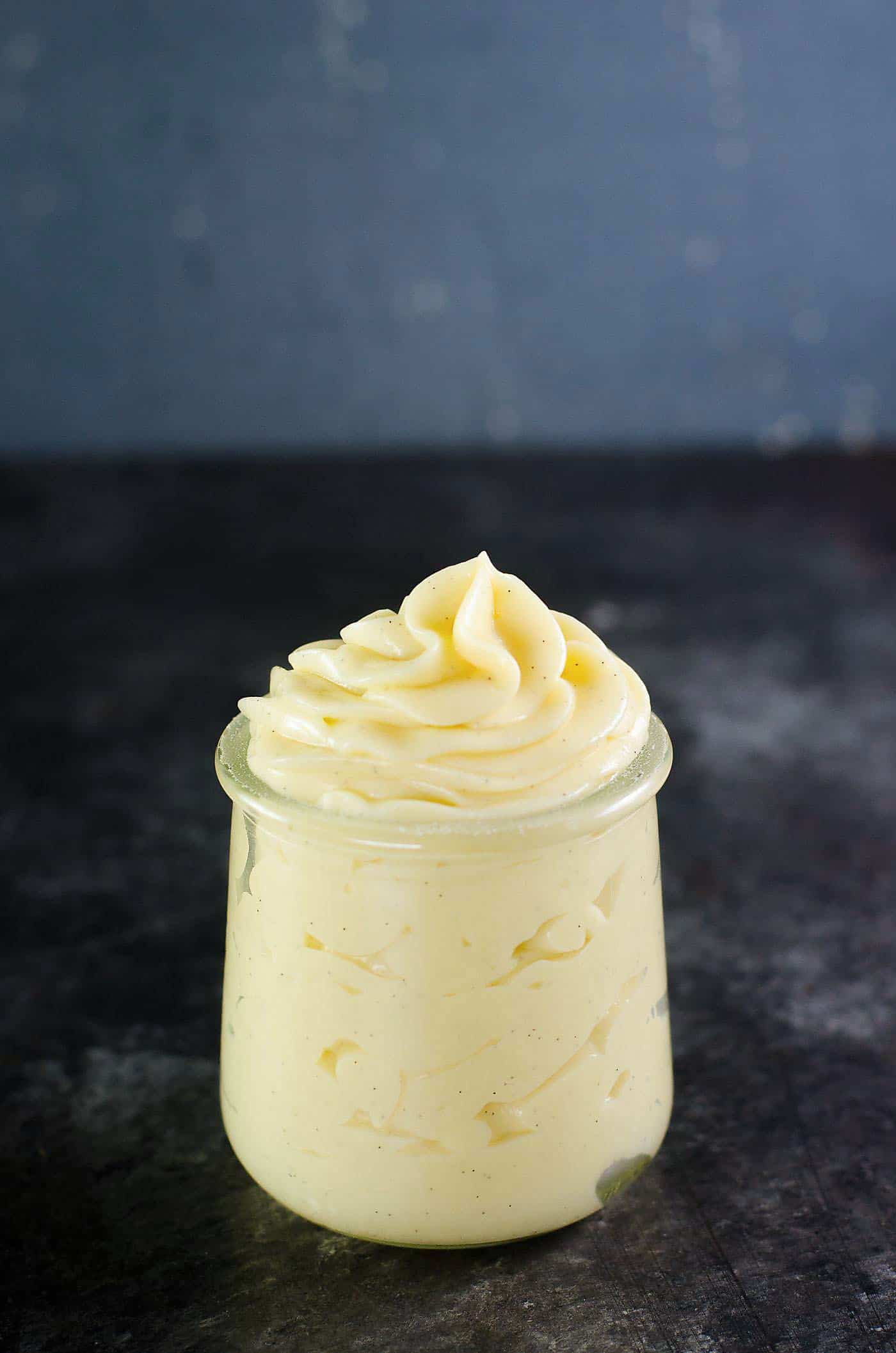
Pastry Cream (or Creme Patissiere) is a quintessential part of pastry making and used as a filling in many pastry recipes. So, it’s an essential skill to learn if you love to bake pastries and other dessert recipes. Creme patissiere is basically a delicious, rich, creamy custard, thickened with starch and eggs. It’s an important component for many desserts.
What is pastry cream (creme patissiere) used for?
- It’s used to fill classic profiteroles and sometimes cream puffs
- To fill chocolate eclairs
- As filling for cakes such as Boston cream pie
- Filling for fruit tarts such as this strawberry tart
- To make mille feuille
- To make vanilla pudding or chocolate pudding
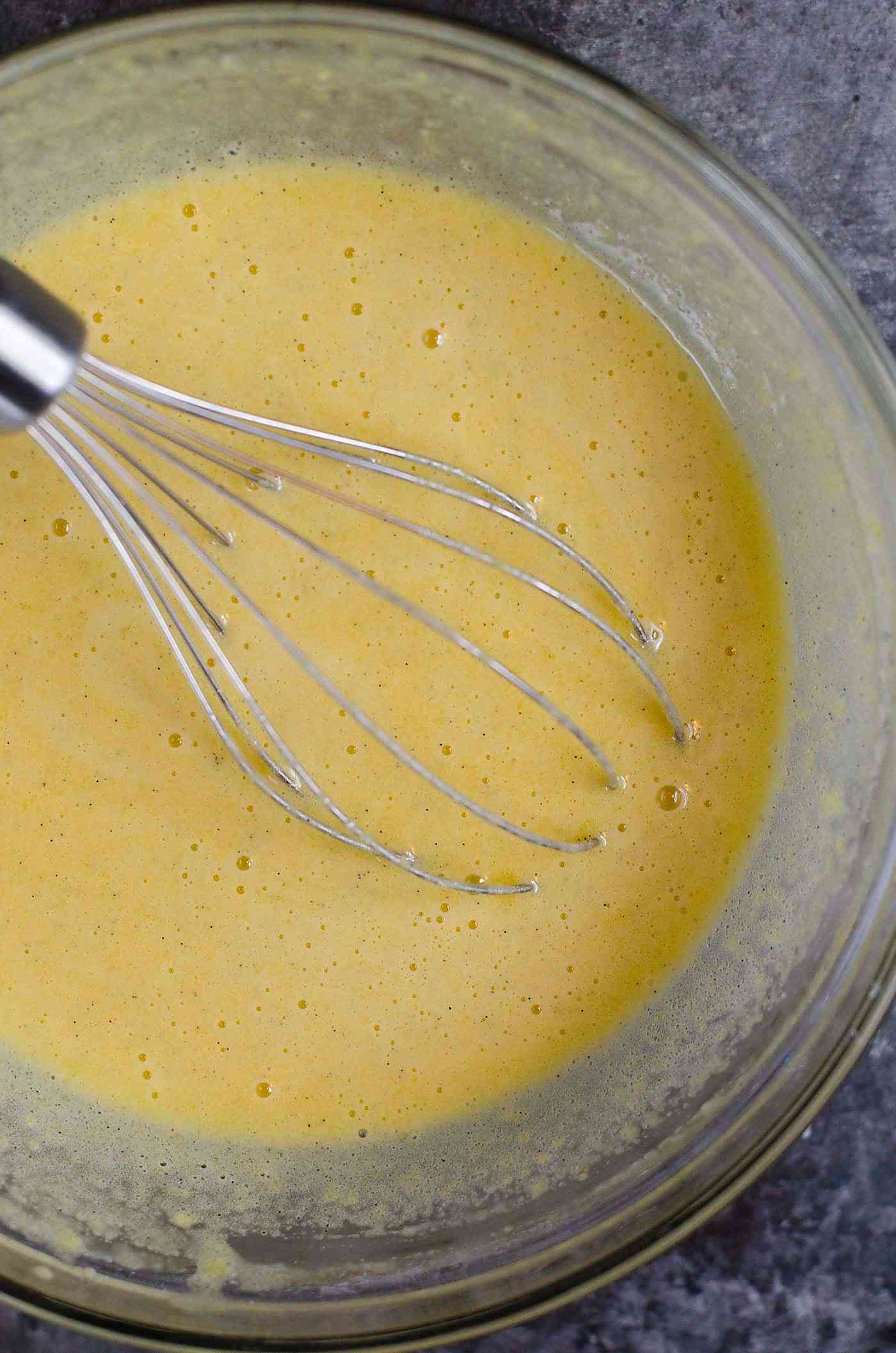
If you’ve never made creme patissiere (vanilla pastry cream) before, you should definitely try it. It’s such an easy and delicious recipe with a lot of great uses.
Types of custard
There is some confusion about custard desserts and their terminology, so I’m going to clear that up before I get into the pastry cream recipe.
- Creme Anglaise (pouring custard) is a runny version of pastry cream. It isn’t typically thickened with a starch (although some use a little cornstarch to prevent egg scrambling), and usually only uses eggs/egg yolks. It’s like a thick sauce that can be poured over desserts. This custard isn’t heated to a boil to prevent the eggs from curdling.
- Creme Chantilly is lightly whipped cream sweetened with sugar and (usually) flavored with vanilla.
- Creme Patissiere is a thicker custard. It’s thickened using starch and eggs/egg yolks and can be piped. It’s mostly used to fill pastries and other desserts. Pastry cream is heated to a boil, so that it thickens well. Because of the starch, the eggs don’t curdle readily.
- Creme Legere is pastry cream (creme patissiere) with sweetened and flavored whipped cream (chantilly) added. Most people call this creme diplomat as well.
- Creme Diplomat is creme patissiere mixed with chantilly, gelatin, and any extra flavorings (optional). It’s basically creme legere made with stabilized whipped cream.
- Creme Bavarois is a dessert on its own. It’s like panna cotta, but made with creme patissiere. It’s creme patissiere mixed with chantilly, but with extra gelatin (so that it sets like a pudding), and extra flavorings.
Creme Patisserie is the base for all of these pastry essentials, so I hope you give this recipe a go!
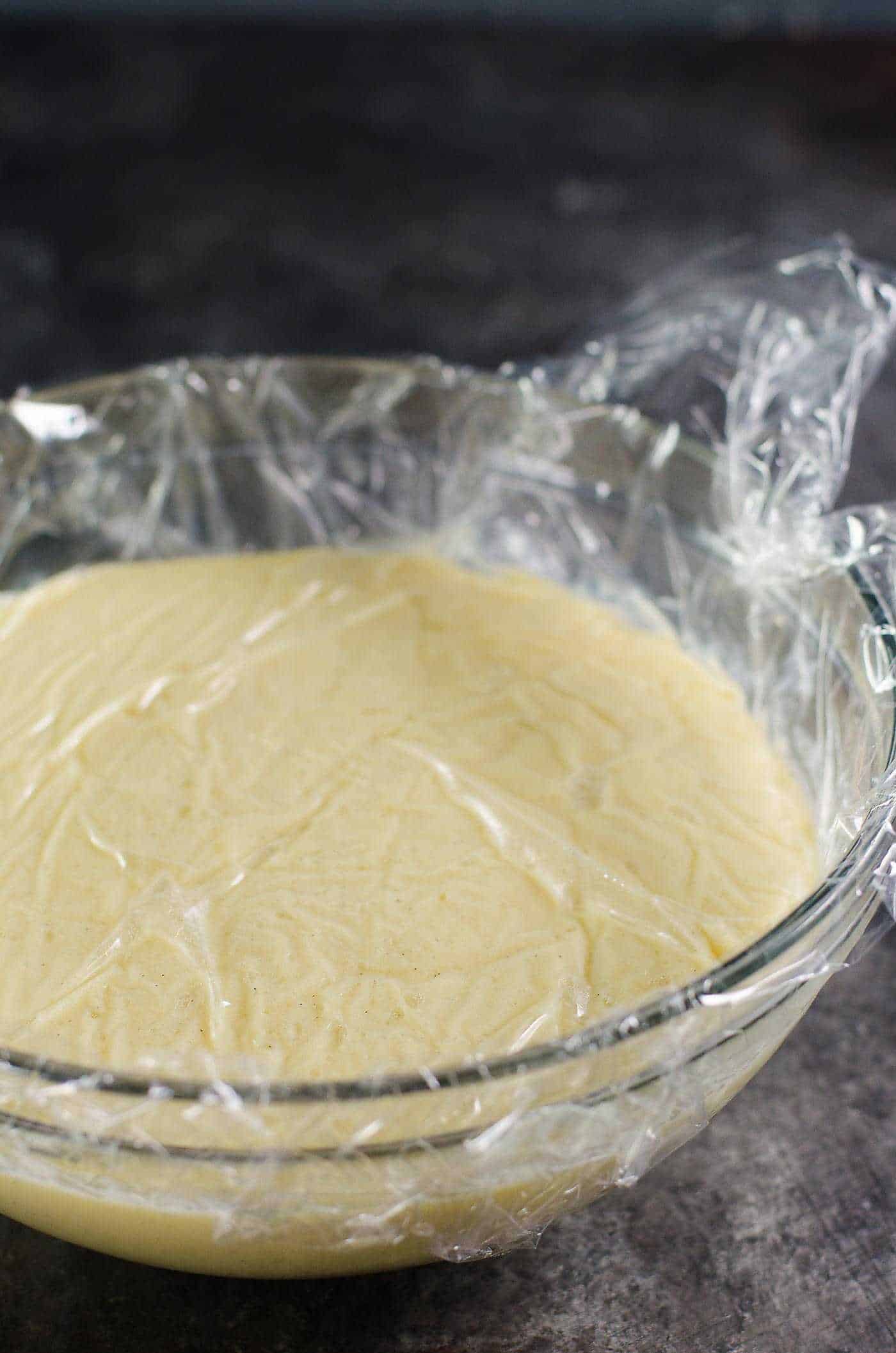
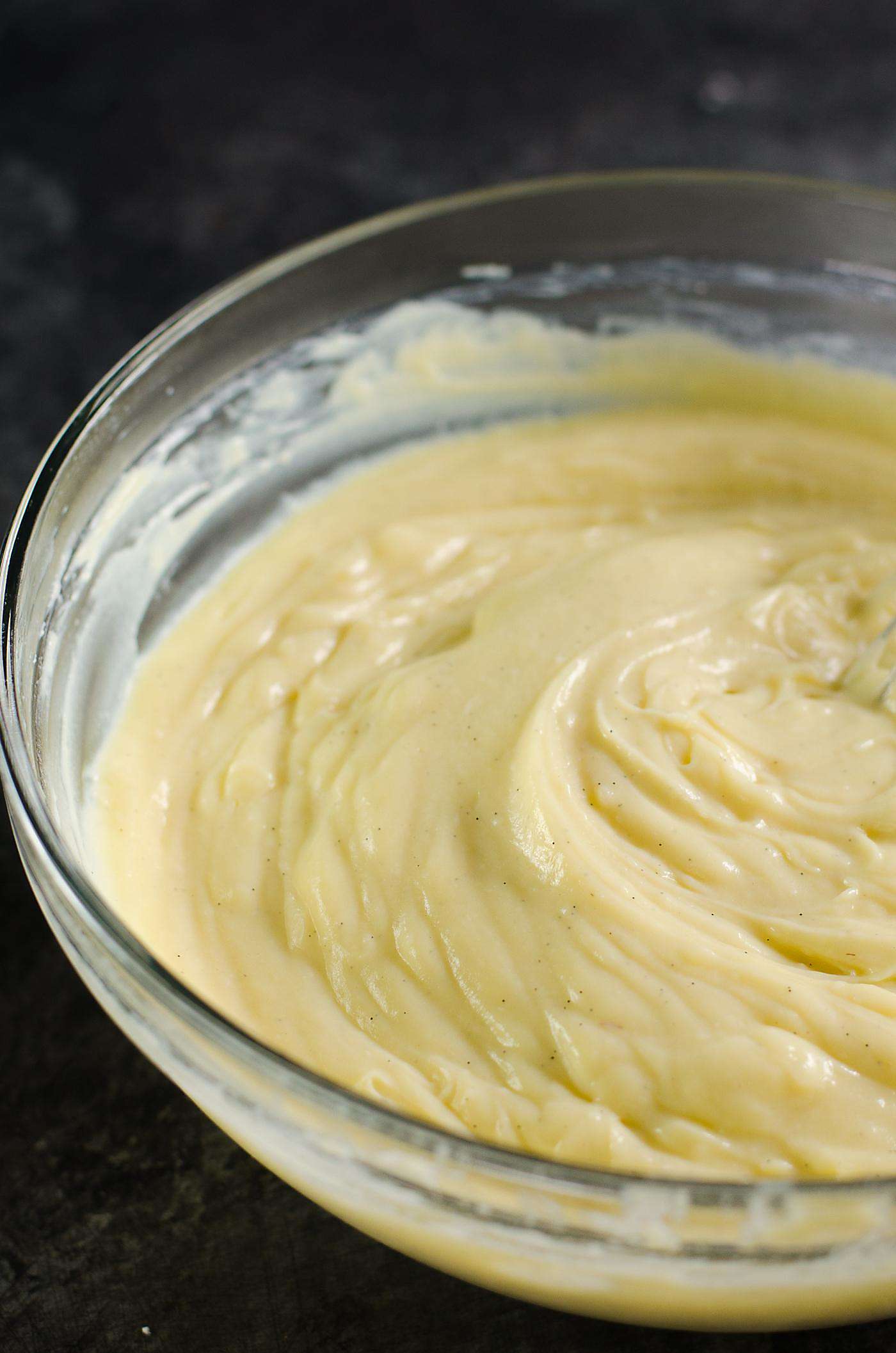
The importance of eggs
You can use a mix of whole eggs and yolks in this recipe OR you can use ALL whole eggs as well.
Eggs (specifically egg yolks) play two roles in creme patissiere (pastry cream). It adds richness (especially the yolks), and also thickens the custard. I use large eggs in this recipe, where an egg weighs 2 oz / 57 g on average, or an egg yolk that weighs about 0.7 oz / 20 g on average. So if you’re using different-sized eggs, you can adjust accordingly. But a little extra egg (or egg yolk) won’t mess up your pastry cream.
I use 4 egg yolks from large eggs OR 3 large egg yolks, plus 1 large egg for this recipe. This pastry cream is delicious and spreadable and pipeable (i.e. isn’t too stiff). If you want a RICHER tasting pastry cream then I’d suggest to use up to 6 large egg yolks instead. This version is slightly thicker because of the extra egg yolks. My usual go to is to about 4 – 5 egg yolks.
The more eggs you add to the milk, it gets richer and tastes better. BUT it will also greatly increase the chances of it turning into scrambled eggs!
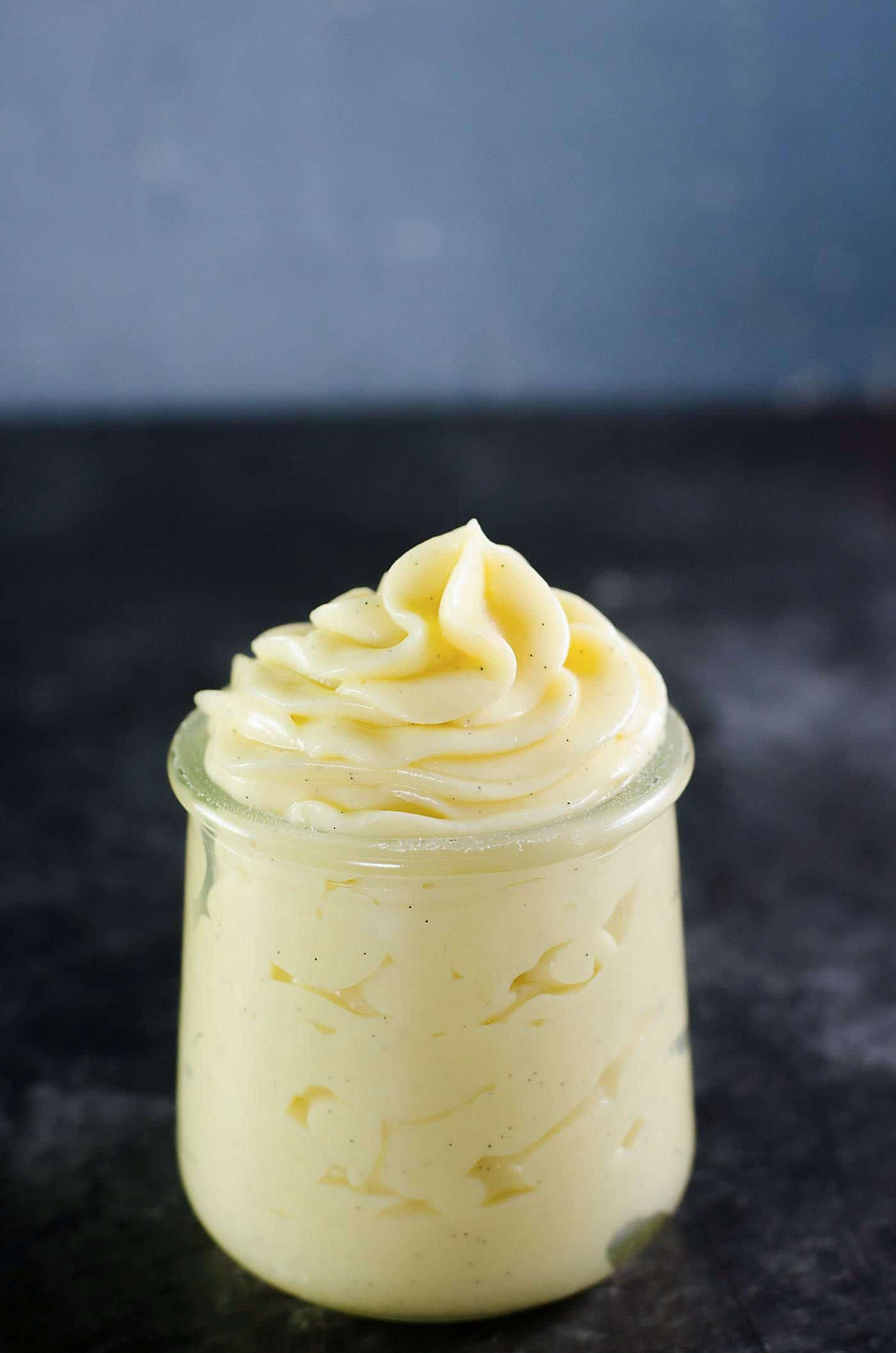
The importance of cornstarch
Pastry cream is cooked with cornstarch. This helps thicken the pastry cream further AND it also acts as a buffer to prevent the eggs from turning into scrambled eggs.
You still need to stir or whisk the pastry cream very frequently to prevent egg scrambling. But the starch in the cornstarch will create a buffering matrix which will reduce the chances of the eggs coagulating.
The more cornstarch you add, the thicker the pastry cream will be.
The uses of pastry cream with different textures
For a softer pastry cream filling, I like to add 30g of cornstarch to my pastry cream. This is great for profiteroles, or even as a thick topping for desserts.
For a firmer pastry cream, I add 40g of cornstarch. This is great to use as a filling for lighter cakes, but I would also add a little gelatin to make it more stable. You can also use a buttercream dam, and fill it with this pastry cream as well. This can also work as a filling for smaller tarts, eclairs, or profiteroles.
You can also use 50g of cornstarch if you like an even thicker, more stable pastry cream. This pastry cream will even pipe well and keep its shape fairly well. Great for cake fillings when used with a little gelatin. I also use this pastry cream as a base for making diplomat cream or chiboust cream.
The thickest pastry cream that I make is with 60g of cornstarch. This pastry cream is EXETREMELY stiff. I use this as a base for mousseline cream or German butter cream, as the extra butter will make this pastry cream much lighter. Both diplomat cream or chiboust cream can also use this pastry cream as a base, but I prefer 50g for those versions as mentioned above.
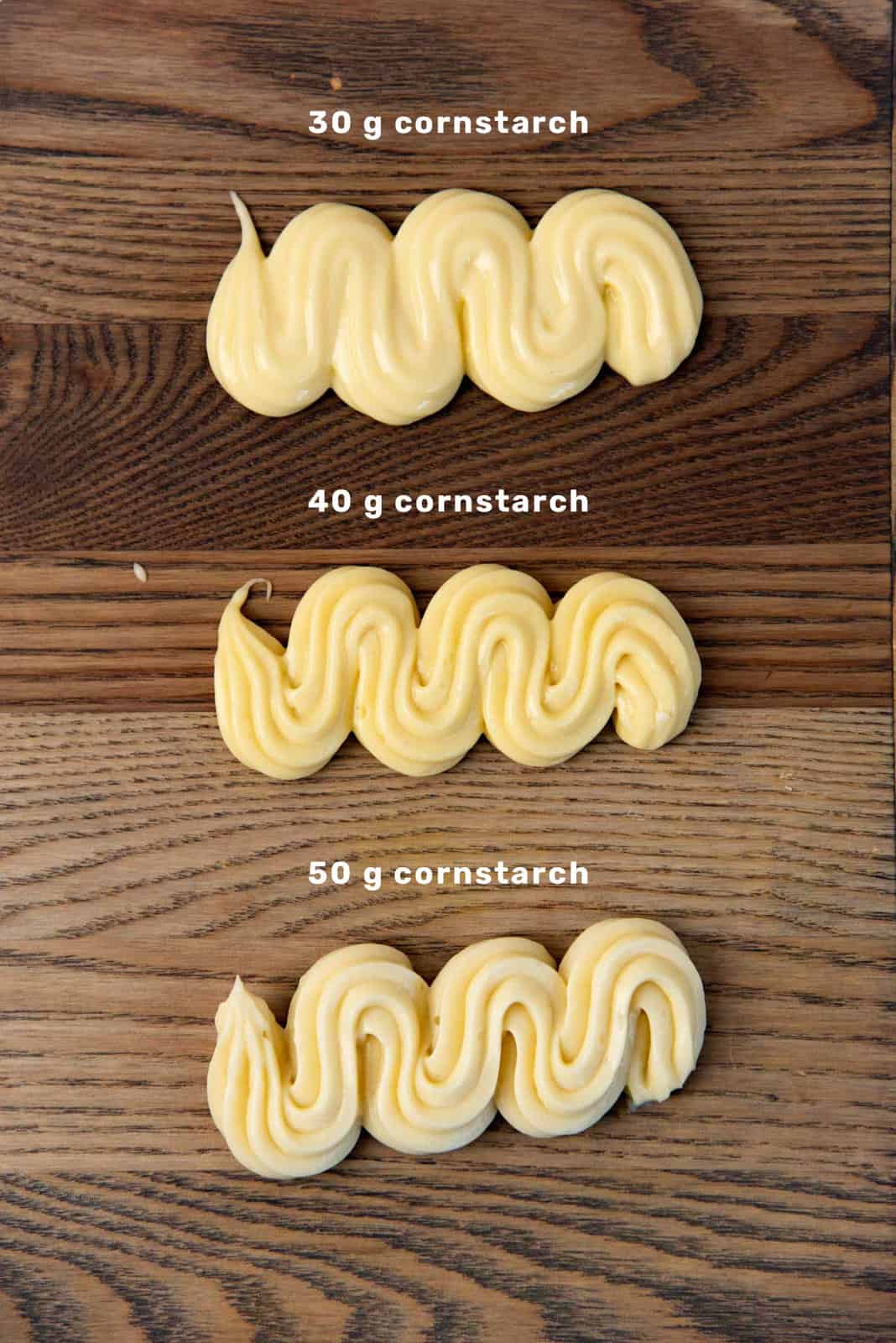
Sweetness level
I personally don’t like my pastry cream to be too sweet. So I only add 6 tbsp (1/4 cup + 2 tbsp) of sugar for every 2 cups of milk. Feel free to adjust the sweetness to your taste. This will change depending on what I will be using the pastry cream for as well.
Recipe tips to make perfect creme patissiere (pastry cream)
The first step is to heat the milk.
Some recipes call to scald the milk, which isn’t necessary if you’re using pasteurized milk. However, if you’re using fresh vanilla beans, scalding the milk with the vanilla and letting it cool down a little will allow the vanilla to infuse into the milk.
I heat the milk until almost to a boil, so that it speeds up the process of dissolving the sugar and thickening.
Make sure to mix the eggs, cornstarch, and sugar together in a separate bowl until you have a nice smooth paste.
This ensures that you have NO LUMPS in the cornstarch, and that the sugar and eggs form a thick paste which will mix in better with the milk. But don’t do this ahead of time. Only mix it together a few minutes before adding the milk. Otherwise the eggs will cook in the sugar.
Some recipes call for the eggs to be whisked until you get ribbons. I do not find this to make a difference. The important part is to make sure the egg mixture is smooth and not at all lumpy.
Be careful when tempering the eggs with the hot milk.
If you’re a beginner, you could get someone to help you whisk the egg mix while you pour the hot milk in a thin stream to temper the eggs.
Another way to temper the eggs is to keep the bowl with the egg-sugar mix on a tea towel (to prevent slipping), and pour the hot milk from a light and small measuring cup (light enough to control with one hand). This makes it easier to whisk the egg mix with one hand and pour hot milk with the other.
Keep whisking and mixing the pastry cream while cooking.
It’s important to keep the milk-egg mix moving while it’s being heated. The milk will curdle when it comes closer to the boiling point, and you do NOT want that! Use a whisk and a spatula to make sure the pastry cream stays smooth.
If you feel that the creme patissiere is heating up too fast, remove it from the heat periodically while stirring.
Bring the vanilla pastry cream to a boil.
Unlike other custards, pastry cream needs to be brought to a boil. The cornstarch will cook well, and you won’t be left with a starchy flavor either.
The heat allows the eggs to form strong protein bonds, and the starch in the cornstarch expands, forming starch bonds that thicken and stabilize the pastry cream. While stirring, allow the pastry cream to come to a boil and then let it cook further for at least 1 minute at low-medium heat.
Strain the pastry cream.
It’s not necessary to strain the creme patissiere unless it’s lumpy. BUT it’s still a good extra measure to make sure the creme patissiere is silky smooth.
Cooling down the pastry cream.
Once the pastry cream is cooked, it needs to cool down completely. To allow the pastry cream to cool down quickly, spread it in a large bowl or shallow pan, so that the custard layer is fairly shallow. Make sure to cover the WHOLE SURFACE with plastic wrap to prevent a skin from forming on the surface.
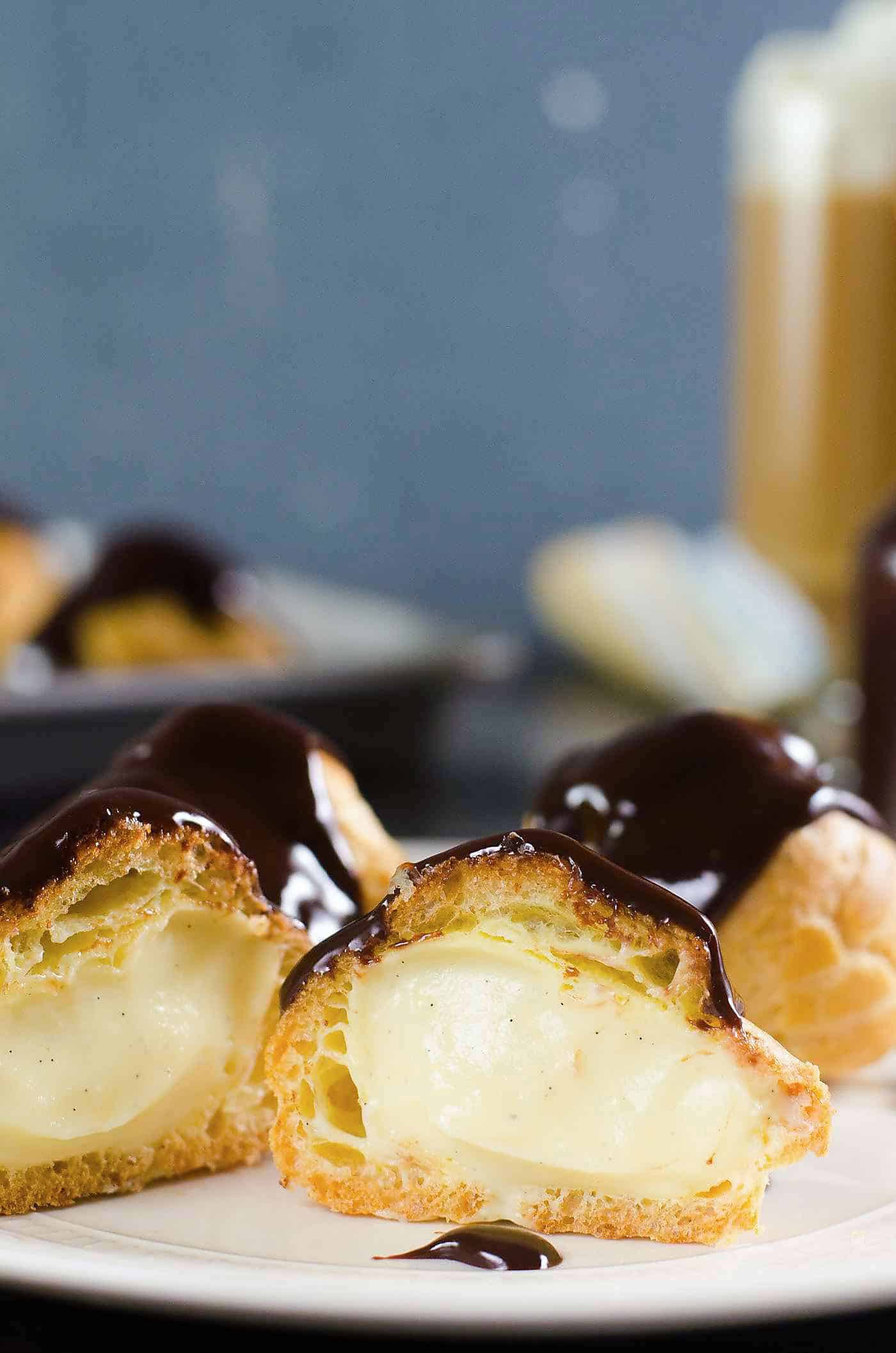
Frequently asked questions about this recipe
This pastry cream recipe is gluten free, because I use cornstarch instead of flour to thicken it. Some pastry cream recipes use flour, or both flour and cornstarch, but that’s not necessary.
I also find that using cornstarch alone makes the pastry cream less likely to taste floury, which is a common issue with pastry cream made with flour.
Yes! As stated above, some recipes make pastry cream with flour. In theory, you will need to increase the flour 3-fold to get the same thickening effect as cornstarch.
I personally have not made this recipe with flour, so it will take some experimentation to determine how much flour is needed.
If you’d like to make this recipe dairy free, substitute the milk with a plant-based milk such as almond milk, coconut milk, cashew milk, or even soy milk. And substitute the butter with a dairy free or vegan butter.
Since vanilla is the key flavoring in this pastry cream recipe, PLEASE make sure to use good quality vanilla. It’s the one flavoring that I never skimp out on.
Use a good vanilla extract and try to avoid vanilla essence (usually imitation flavor), and if you can use vanilla bean paste or vanilla beans, even better.
This happens if you’ve heated the pastry cream at too high of a temperature or you didn’t stir it well when it was coming to a boil.
But don’t worry, whisk it VERY well to get rid of the lumps (off the heat), or if that doesn’t work, pass it through a sieve as soon as you’ve cooked it.
This happens if you haven’t cooked the pastry cream properly. This recipe makes a pastry cream that is spreadable and pipeable, but it’s not stiff enough to hold its shape. If you did want a stiffer and thicker vanilla pastry cream, you can increase the amount of cornstarch.
If you added extra cornstarch and it’s still not thick enough, you absolutely need to allow the pastry cream to bubble (boil) and cook for a minute while whisking to activate the cornstarch thickening properties.
If you used an aluminum pot to make the custard, chances are that some of that aluminum can get into the pastry cream. Use a stainless steel pot, a copper pot, or a non-stick pot.
If you did not cook the pastry cream properly to activate the cornstarch, then it will taste a little starchy.
Chances are you added too much cornstarch. If you compacted the cornstarch into your measuring spoon, or used an incorrect measuring spoon, this could happen.
You can fold in a little stabilized chantilly cream to loosen up the pastry cream to achieve the right consistency – like a creme diplomat.
This happens if the pastry cream was cooked at too high of a heat and it curdled at some point. Even though you whisked the mixture to break down the curdled egg, and passed it through a sieve, some of the curdled egg is still there.
It has dispersed through the custard making it feel grainy. Unfortunately, there is no fix for this and it needs to be made again.
As the recipe stands, you can use this as a cake filling ONLY if you have a buttercream damn along the edge of your cake. The pastry cream is too soft and will run out the sides if not.
If you want to have a thicker pastry cream as a filling, then I recommend making the pastry cream with 40 – 50 g of cornstarch. Adding about 2 tsp of bloomed gelatin will also increase the stability of the pastry cream to be used as a filling.
And if the cake layers are heavy, I ALWAYS recommend a buttercream dam simply because the pastry cream will squeeze out the sides if the cake layers are heavy.
Storage instructions
Never keep the vanilla pastry cream outside. It’s made with milk and eggs that go bad when not refrigerated. The pastry cream will go bad if stored at room temperature.
Pastry cream cannot be frozen for later. This is because the starch and protein bonds that thicken the creme patissiere will break down when frozen. And as the pastry cream thaws out, it will weep and create too much moisture, making it runny, which will ruin the consistency.
The best way to store pastry cream is in the fridge, in an air-tight container, with a piece of plastic wrap covering the entire surface of the pastry cream. Pastry cream will last about 3 – 4 days in the fridge. This means you can make vanilla pastry cream ahead of time for your recipes too.
Recipe variations
- Chocolate pastry cream (chocolate creme patissiere)
- Earl grey pastry cream
- Lighter, sweeter salted caramel diplomat cream version.
EQUIPMENT & TOOLS I USE FOR THIS RECIPE
- Whisks and silicone spatula – to stir the pastry cream
- Plastic wrap
- Pyrex glass containers with lids – to store the pastry cream (remember to cover the surface with plastic wrap).
- Measuring cups & spoons
Looking for more recipes?Sign up for my free recipe newsletter to get new recipes in your inbox each week! Find me sharing more inspiration on Pinterest and Instagram.
Creme Patissiere (Vanilla Pastry Cream)
Ingredients:
- 2 cups milk
- 6 tbsp sugar
- Pinch of salt
- 3 tbsp cornstarch (cornflour) packed tablespoons (4 tbsp / 40 g for a stiffer pastry cream). You can also add up to 50 g / 5 tbsp if you want a thicker, more stable pastry cream.
- 1 tbsp vanilla bean paste / extract / 1 vanilla bean pod
- 4 large egg yolks about 20 g each (please see recipe notes)
- 3 tbsp unsalted butter softened
Adding gelatin (Optional)
- 3 tbsp water
- 1½ tsp powdered gelatin 225 bloom strength
Instructions:
- If using vanilla bean pods, split the bean and scrape the vanilla seeds/caviar out of the beans.1 tbsp vanilla bean paste / extract / 1 vanilla bean pod
- Add the bean and caviar with the milk into a saucepan. Heat the milk over medium high heat and bring it to a simmer, almost to a boil (see recipe notes).2 cups milk
- While heating the milk, place the sugar, egg yolks, cornstarch, and salt in a bowl. Whisk until you have a thick, smooth mix. (If you're using vanilla bean paste or extract, add it to the egg mix too). Place the bowl with the egg mix on a towel or napkin (to prevent the bowl from slipping while whisking, in the next step), and set aside until the milk comes to a boil (almost to a boil).6 tbsp sugar, Pinch of salt, 3 tbsp cornstarch (cornflour), 4 large egg yolks, 1 tbsp vanilla bean paste / extract / 1 vanilla bean pod
- As soon as the milk starts to steam or simmer, remove it from the heat. Slowly pour about a half of the hot milk in a thin stream into the egg mix, WHILE WHISKING CONSTANTLY to temper the egg mix. When the eggs have been tempered, add the egg mix back into the hot milk in the saucepan.
- Heat the custard base, over medium heat, while whisking vigorously until it starts to thicken – this should take about 1 – 2 minutes depending on the heat of your stove and size of your saucepan. Make sure to reach the corners of the saucepan so that the custard does not catch at the bottom of the pan.
- While whisking, let the custard come to a boil (the custard will release bubbles). You may need to stop whisking from time to time for a few seconds to see if the custard is "bubbling". Look for big "bloops" breaking the surface of the custard.
- Lower the heat and cook for a further 1 – 2 minutes after you see the first bubbles break the surface, and make sure to whisk constantly.
- Remove from the heat and add the butter. Whisk in the butter, until it’s completely mixed in.3 tbsp unsalted butter
- Pour the custard into a bowl and immediately cover the surface with plastic wrap, making sure the plastic wrap is touching the whole surface. This is to prevent a custard skin from forming on top. You can also choose to pass the custard through a sieve to remove any lumps.
- Let the custard cool down to room temperature and then let it chill in the fridge for a few hours, until it’s completely chilled.
- The custard will have "set" after chilling. So it is important to whisk the pastry cream to make it smooth before using.
- Use as needed after the pastry cream has been chilled.
Adding gelatin
- Gelatin should be added to the pastry cream WHILE IT'S STILL HOT. Please read notes on whether adding gelatin to your pastry cream is the right option for you.
- While the milk is heating (for the pastry cream), place the water in a small bowl.3 tbsp water
- Sprinkle the gelatin over the water and use a toothpick or skewer (something slim) to mix the gelatin into the water so that there is no dry gelatin. Let this sit for at least 10 minutes to bloom (or until the pastry cream has been cooked and thickened).1½ tsp powdered gelatin
- While the pastry cream is hot, add the bloomed gelatin along with the butter and whisk thoroughly to make sure all the gelatin has dissolved in the hot pastry cream.
- Cover the pastry cream with plastic wrap (same as above), and keep an eye on the pastry cream. Let it come to room temperature and then use the pastry cream as needed. If you chill the pastry cream it will harden as the gelatin sets.
Tips & Tricks
- For a thicker and richer vanilla creme patissiere, you can add up to 6 egg yolks.
- Increase the amount of cornstarch up to 50 g for a thicker pastry cream.
- For a dairy-free version, substitute the milk and butter with a plant-based milk such as almond milk, coconut milk, cashew milk, or even soy milk, and use a plant-based butter.
- You can choose to bring the milk to a boil, or just let it come to a simmer. It was important to boil the milk back in the days when milk wasn’t pasteurized. However, I have not noticed any difference in the pastry cream consistency when using boiling milk vs steaming hot milk.
- Here’s the recipe for classic vanilla diplomat cream (crème diplomat).
- Here’s the recipe for classic chocolate pastry cream.
Adding gelatin to your pastry cream.
You can absolutely add gelatin to your pastry cream for any reason. If you allow your pastry cream cool in the fridge, the gelatin will set. You can still re-whisk and use this pastry cream as normal, but it won’t “set” the same way as before. For proper setting properties, allow the pastry cream to cool to room temperature completely. Then you may use it for any application you please. This means, you cannot make it ahead of time. You can add whipped cream to it to make diplomat cream (and you do not have to add extra gelatin to the whipped cream). You may also add Italian meringue to make chiboust cream as well.Nutrition Information:
“This website provides approximate nutrition information for convenience and as a courtesy only. Nutrition data is gathered primarily from the USDA Food Composition Database, whenever available, or otherwise other online calculators.”

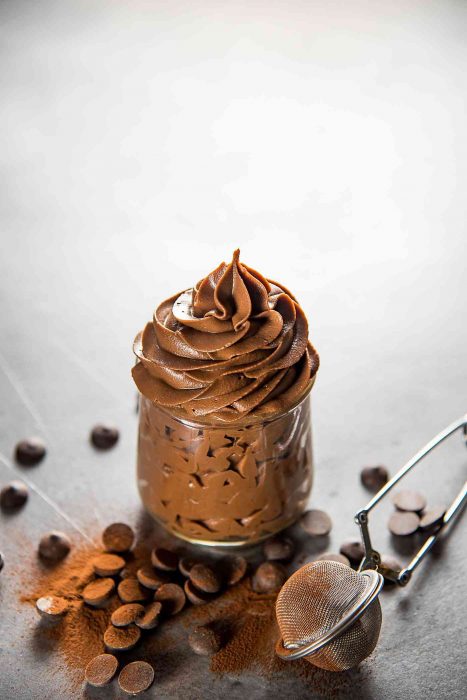
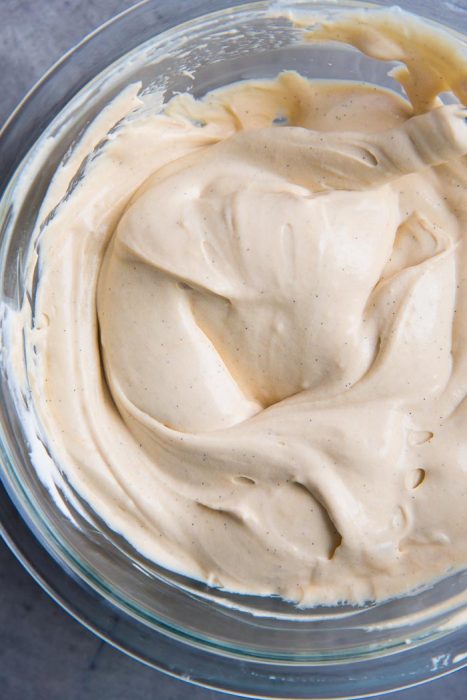
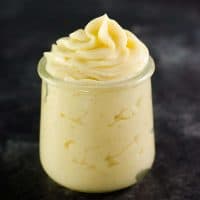
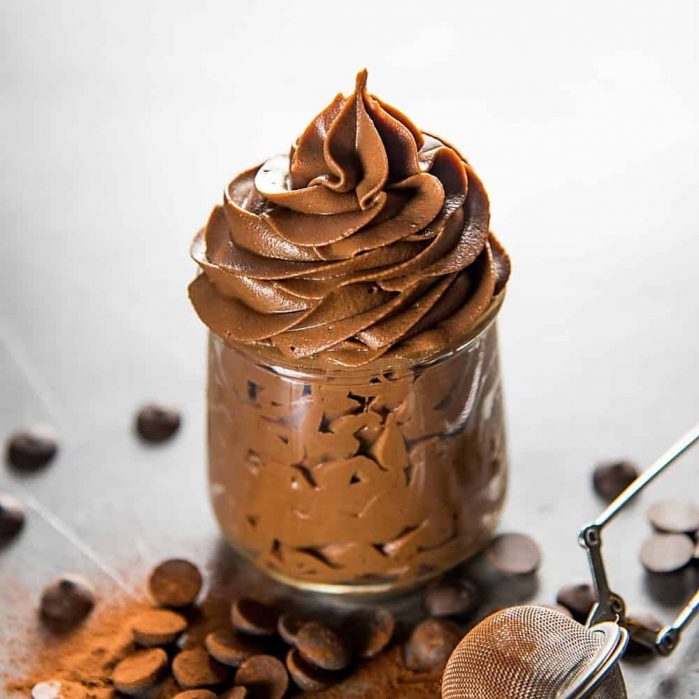
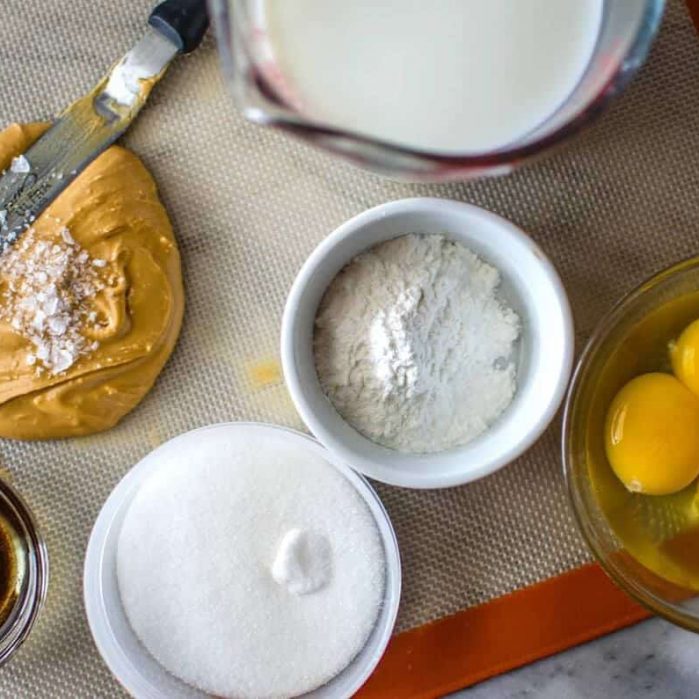
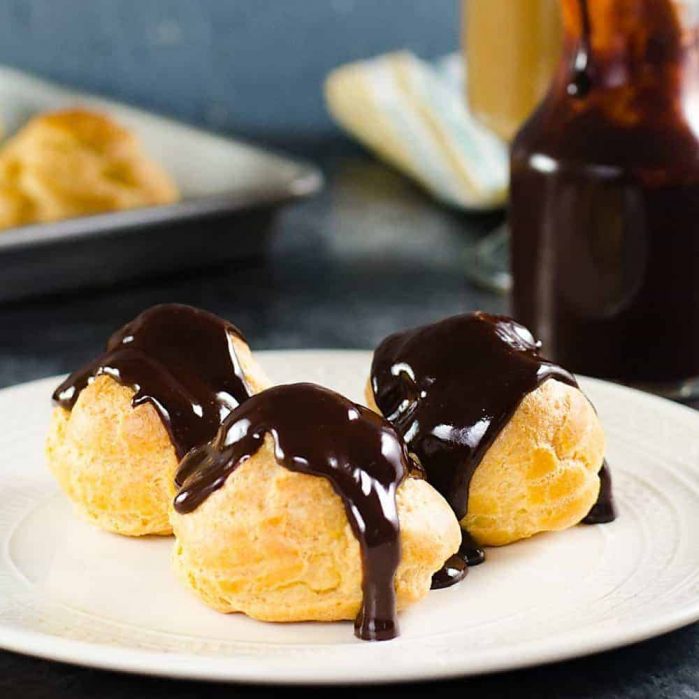
Crystal miller says
Fantastic pastry cream. Easy and delicious. Followed the recipe exactly. Refrigerated overnight. Thanks
Teri Hamsher says
Awesome recipe! No more burned pans or too runny custard filling. Finally found the best recipe after 40 years.
Anya says
I have done this recipe 3 different times and it came out beautifully each time. I am not sure why it took me this long to come here and say that lol. Thank you for the easy recipe- it sure did not look this easy on the British Baking Show :). Also, thank you for the breakdown of the different creme used in pastry- I learned a lot!
Laura says
I had 6 egg yolks I didn’t know what to do with, so I gave creme patissiere a shot! Perfect for cream puffs, and absolutely delicious. I need to try the chocolate crem patissiere next.
Bonnie M. says
Thank you for this easy recipe! First time making crème pat. Absolutely divine. Had a hard time not gobbling half the custard. Easy to follow. Not too sweet. Perfect consistency. So excited to try this for my crème brûlée donuts.
Rachael says
Just leaving a warning for those with gas stoves… Definitely do not let the heat get too high. I tried low heat, then low-medium and it instantly curdled :,( it never even boiled. This is the first time I’ve made custard and had it cuddle this bad and so instantly… Very sad. And the last time I made it it was too runny, even though it seemed thick in the pot. Did not turn out..
Dini says
Hi Rachael
It’s definitely trickier to get the temperature right with gas stoves, as they are more powerful and harder to control. However, I have made this using gas stoves multiple times and it is absolutely possible.
The custard will come to a boil. The custard must be whisked fast and well when heating to prevent curdling. Especially with gas stoves (or electric stoves) when the heat is higher. You cannot leave the custard unattended. I hope that helps.
Lisa says
Hi Rachael. I tried it 3 times and the 3rd time it worked. The first two times it looked like it was done in the pot but after it cooled it became liquidy. The third time worked because I waited till I saw a big bubble come up…not just taking it off the heat because it thickened (when you think its done). So that is the key, wait for the big bubble and then keep stirring for a minute.
Dini says
Hi Lisa
You are absolutely correct!
Once the bubbles appear you must cook the custard for at least 1 minute further, if cooking on low heat as stated in my recipe as well!
The cornstarch must fully activate for it to be able to fully thicken the liquid. This happens only when the cornstarch in the liquid is boiled.
Otherwise the pastry cream will lose it’s thick texture as it cools down!
Mikayla Archibald says
If you didn’t boil long enough can you put back on stove bring back to a boil to thicken? Or after it’s set that’s that
Dini says
Hi Mikayla
You could. However the water will evaporate more because of the second cook time and this can result in a thicker pastry cream. Be especially mindful about the custard curdling as the eggs are now being “cooked” a secind time as well.
I hope that helps.
Carol says
So good! hard to not eat while still warm, Thank you for this wonderful recipe.
Fay says
Just in time for Christmas dessert/ sweet. I’m planning to make steamed buns with custard fillings. Tried out the recipe in a small batch and it works so well. I’ll be making big batch of steamed custard buns this year. Thank you.
Cyndi Thompson says
Just made this and it’s delicious! Texture is smooth and creamy. Next up are the profiteroles
Barry says
Thank you for your beautifully presented recipe. I used soy milk 350ml, thickened cream 150ml with brown sugar 80g and 4 egg yolks to make a really rich tadting custard. Also ended up adding extra scoops of monk fruit sugar to compensate for my very sweet tooth.
I’m probably going to try 500mls thickened cream and 6 yolks to give myself an early heart attack in my next attempt lol.
Kenny says
Made this!… with some differences since I have a hard time following recipes lol.
I used whole eggs instead is separating. Of course, they curdled like crazy. Easy fix = just use your immersion blender and blend the little boogers out of it 🙂 turned out silky smooth and tasted great. I guess you could strain it instead, but the blender is more fun and less mess.
I used strawberry milk since I have gallons of it. Fun experiments! Setup great at the end.
Great base recipe! Thanks!Kenny
Dini says
Hi Kenny
I am so glad that you were able to fix it!
You can still create pastry cream with whole eggs without curdling it. The tempering should be done slowly and you have to constantly stir the custard. A little extra cornstarch can also help stabilize it. Even with a stick blender, sometimes the cutard can have a grainy mouthfeel once it has chilled (especially if the curdling goes to far).
The reason I do not use whole eggs here is because the egg whites add extra liquid to the pastry cream as well, and the resulting pastry cream will not be as thick or pipeable. Hence, why I tested and created a recipe that is easier to make, with fool proof results that is thick enough to be used as a filling.
Hope that helps!
Lauren says
If I wanted to make this maple flavored, would you suggest maple extract in place of the vanilla, or maple syrup? I trust your recipe and have been successful with it!
Dini says
Hi Lauren
You can abosolutely replace the sugar with maple syrup! Instead of 75 g of sugar, I would add 75 g maple syrup. I would also increase the cornstarch from 30 g to 40g, due to the higher water content (or higher for an even stiffer pastry cream, depending on what you will be using it for).
In Canada, you can also get maple sugar, which can also be used to replace the sugar as well.
I hope that helps!
Flo says
Is this recipe the same as Barvarian cream for Horn or cream buff filling?
Dini says
Hi Flo
Bavarian cream filling that is used for pastries is actually Diplomat cream. Diplomat cream is pastry cream mixed with whipped cream.
You can follow my Diplomat Cream recipe to make Bavarian cream filling. Pastry cream can also be used as a filling, but it can be heavier and richer, while diplomat cream is lighter and airier than pastry cream. I hope that helps!
Mamma Orsa says
Thank you for the amazing recipe!
The detail and clarity of your recipe, helped me overcome the issues I have had in making pastry cream.